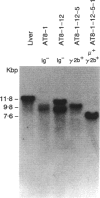Abstract
AT8--1-12--5-1, an Abelson virus-transformed immature B-cell line, produced truncated mu-chains. Sequencing analysis of the mu-expressed allele revealed that the variable region was an out-of-frame VH7183-DSP2-JH3 complex. Two cDNA clones (5-1 cDNA1 and 5-1 cDNA2) derived from the transcripts of the mu-expressed allele were cloned and sequenced. Sequencing analysis of 5-1 cDNA1 revealed that the VH7183-DSP2-JH3 sequence jointed to the CH1 exon at 136 bp, 3' from the 5' end of the CH1 exon, resulting in the change of the reading frame from out-of-frame to in-frame. On the other hand, sequencing analysis of 5-1 cDNA2, which appeared to have derived from intron-containing premature mRNA, revealed that the J-C intron sequence joined to the CH1 exon at 110 bp 3' from the 5' end of the CH1 exon, indicating the deletion of 109 bp including the 3' splice site of the CH1 exon. These results demonstrate that the deletion of the authentic 3' splice site of the CH1 exon induced activation of the cryptic splice site within the CH1 exon. This was followed by splicing of the variable region to the CH1 exon at the cryptic splice site at 136 bp 3' from the 5' end of the CH1 exon, resulting in the change of the reading frame from out-of-frame to in-frame, followed by the truncated mu-chain production.
Full text
PDF




Images in this article
Selected References
These references are in PubMed. This may not be the complete list of references from this article.
- Alexander A., Anicito I., Buxbaum J. Gamma heavy chain disease in man. Genomic sequence reveals two noncontiguous deletions in a single gene. J Clin Invest. 1988 Oct;82(4):1244–1252. doi: 10.1172/JCI113722. [DOI] [PMC free article] [PubMed] [Google Scholar]
- Baczynsky W. O., Sugii S., Murialdo H., Pennell N., Filkin C., Hozumi N., Shulman M. J. Nucleotide sequences of immunoglobulin mu heavy chain deletion mutants. Nucleic Acids Res. 1983 Nov 11;11(21):7471–7485. doi: 10.1093/nar/11.21.7471. [DOI] [PMC free article] [PubMed] [Google Scholar]
- Bakhshi A., Guglielmi P., Siebenlist U., Ravetch J. V., Jensen J. P., Korsmeyer S. J. A DNA insertion/deletion necessitates an aberrant RNA splice accounting for a mu heavy chain disease protein. Proc Natl Acad Sci U S A. 1986 Apr;83(8):2689–2693. doi: 10.1073/pnas.83.8.2689. [DOI] [PMC free article] [PubMed] [Google Scholar]
- Bentaboulet M., Mihaesco E., Gendron M. C., Brouet J. C., Tsapis A. Genomic alterations in a case of alpha heavy chain disease leading to the generation of composite exons from the JH region. Eur J Immunol. 1989 Nov;19(11):2093–2098. doi: 10.1002/eji.1830191119. [DOI] [PubMed] [Google Scholar]
- Brandt C. R., Morrison S. L., Birshtein B. K., Milcarek C. Loss of a consensus splice signal in a mutant immunoglobulin gene eliminates the CH1 domain exon from the mRNA. Mol Cell Biol. 1984 Jul;4(7):1270–1277. doi: 10.1128/mcb.4.7.1270. [DOI] [PMC free article] [PubMed] [Google Scholar]
- Cogné M., Mounir S., Mahdi T., Preud'homme J. L., Nau F., Guglielmi P. Production of an abnormal mu chain with a shortened VHIV subgroup variable region in a Burkitt's lymphoma cell line. Mol Immunol. 1990 Sep;27(9):929–934. doi: 10.1016/0161-5890(90)90160-2. [DOI] [PubMed] [Google Scholar]
- Dunnick W., Rabbitts T. H., Milstein C. An immunoglobulin deletion mutant with implications for the heavy-chain switch and RNA splicing. Nature. 1980 Aug 14;286(5774):669–675. doi: 10.1038/286669a0. [DOI] [PubMed] [Google Scholar]
- Guglielmi P., Bakhshi A., Cogne M., Seligmann M., Korsmeyer S. J. Multiple genomic defects result in an alternative RNA splice creating a human gamma H chain disease protein. J Immunol. 1988 Sep 1;141(5):1762–1768. [PubMed] [Google Scholar]
- Komori T., Sugiyama H., Kishimoto S. A novel VHDJH to JH joining that induces H chain production in an Ig-null immature B cell line. J Immunol. 1989 Aug 1;143(3):1040–1045. [PubMed] [Google Scholar]
- Köhler G., Potash M. J., Lehrach H., Shulman M. J. Deletions in immunoglobulin mu chains. EMBO J. 1982;1(5):555–563. doi: 10.1002/j.1460-2075.1982.tb01208.x. [DOI] [PMC free article] [PubMed] [Google Scholar]
- Mounir S., Guglielmi P., Preud'homme J., Nau F., Cogné M. Alternate splice sites within the human VH gene coding sequences lead to truncated Ig mu-chains. J Immunol. 1990 Jan 1;144(1):342–347. [PubMed] [Google Scholar]
- Mount S. M. A catalogue of splice junction sequences. Nucleic Acids Res. 1982 Jan 22;10(2):459–472. doi: 10.1093/nar/10.2.459. [DOI] [PMC free article] [PubMed] [Google Scholar]
- Pollok B. A., Anker R., Eldridge P., Hendershot L., Levitt D. Molecular basis of the cell-surface expression of immunoglobulin mu chain without light chain in human B lymphocytes. Proc Natl Acad Sci U S A. 1987 Dec;84(24):9199–9203. doi: 10.1073/pnas.84.24.9199. [DOI] [PMC free article] [PubMed] [Google Scholar]
- Sugiyama H., Akira S., Yoshida N., Kishimoto S., Yamamura Y., Kincade P., Honjo T., Kishimoto T. Relationship between the rearrangement of immunoglobulin genes, the appearance of a B lymphocyte antigen, and immunoglobulin synthesis in murine pre-B cell lines. J Immunol. 1982 Jun;128(6):2793–2797. [PubMed] [Google Scholar]





